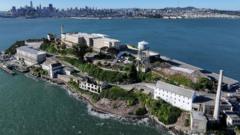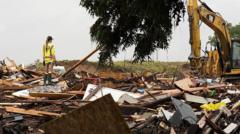Experts question the reality of refurbishing the dilapidated prison island, once a symbol of law and order.
**Trump's Alcatraz Reopening Proposal: A Historical Vision or Unrealistic Dream?**

**Trump's Alcatraz Reopening Proposal: A Historical Vision or Unrealistic Dream?**
In an unexpected move, President Trump proposes to reopen Alcatraz, sparking debates on feasibility and costs.
Alcatraz Island—home to the infamous federal penitentiary, now a revered museum—may soon be in the spotlight again as President Donald Trump revives interest in reopening the facility for housing inmates. Citing concerns over rising criminal activity, Trump envisions Alcatraz, with its historic past, as a modern-day icon of law enforcement. However, numerous experts and former prison officials are voicing doubts over the feasibility of such a plan.
Originally functioning as a military fortress, Alcatraz evolved into a federal prison in 1934, hosting notorious criminals like Al Capone and Mickey Cohen. The prison's closure in 1963 largely stemmed from its high operational costs—estimated to be significantly more than that of other institutions. Since then, the site has transformed into a popular tourist destination, drawing over 1.4 million visitors annually.
In several statements, Trump mentioned his desire to transform Alcatraz back into a correctional facility. His perspective is that by utilizing this historic location, the U.S. could send a message about public safety and order. "We need law and order in this country," he emphasized, pointing to Alcatraz as a powerful symbol.
Despite Trump's enthusiasm, the intricacies of reopening the prison have raised multiple concerns among experts. Former Bureau of Prisons official Hugh Hurwitz deemed the idea highly impractical, suggesting that extensive renovations—or even a complete teardown—would be necessary. Many of the buildings on Alcatraz are in decay, lacking modern security measures, infrastructure, and sanitation.
Beyond structural challenges, historians like Jolene Babyak have underlined environmental concerns that would need addressing. In its earlier years, waste management was rudimentary; today's standards would require significant resources to remedy old sewage systems unsuitable for modern use.
Even as officials like the Department of Justice spokesman hinted at plans for refurbishment, historians like John Martini reiterate the substantial financial hurdles involved. It was previously deemed thrice as costly to operate Alcatraz than other federal prisons—suggesting today's costs would be prohibitive, especially when current federal institutions struggle with their own financial challenges.
Trump's proposal highlights not only the nostalgia associated with Alcatraz but also the complexities of repositioning historical sites for contemporary functions. While the idea captures public imagination, experts urge caution and realism when considering a future for the seemingly weathered "Rock." The debate continues: can a place so entrenched in history realistically evolve into a modern correctional facility?
Originally functioning as a military fortress, Alcatraz evolved into a federal prison in 1934, hosting notorious criminals like Al Capone and Mickey Cohen. The prison's closure in 1963 largely stemmed from its high operational costs—estimated to be significantly more than that of other institutions. Since then, the site has transformed into a popular tourist destination, drawing over 1.4 million visitors annually.
In several statements, Trump mentioned his desire to transform Alcatraz back into a correctional facility. His perspective is that by utilizing this historic location, the U.S. could send a message about public safety and order. "We need law and order in this country," he emphasized, pointing to Alcatraz as a powerful symbol.
Despite Trump's enthusiasm, the intricacies of reopening the prison have raised multiple concerns among experts. Former Bureau of Prisons official Hugh Hurwitz deemed the idea highly impractical, suggesting that extensive renovations—or even a complete teardown—would be necessary. Many of the buildings on Alcatraz are in decay, lacking modern security measures, infrastructure, and sanitation.
Beyond structural challenges, historians like Jolene Babyak have underlined environmental concerns that would need addressing. In its earlier years, waste management was rudimentary; today's standards would require significant resources to remedy old sewage systems unsuitable for modern use.
Even as officials like the Department of Justice spokesman hinted at plans for refurbishment, historians like John Martini reiterate the substantial financial hurdles involved. It was previously deemed thrice as costly to operate Alcatraz than other federal prisons—suggesting today's costs would be prohibitive, especially when current federal institutions struggle with their own financial challenges.
Trump's proposal highlights not only the nostalgia associated with Alcatraz but also the complexities of repositioning historical sites for contemporary functions. While the idea captures public imagination, experts urge caution and realism when considering a future for the seemingly weathered "Rock." The debate continues: can a place so entrenched in history realistically evolve into a modern correctional facility?





















